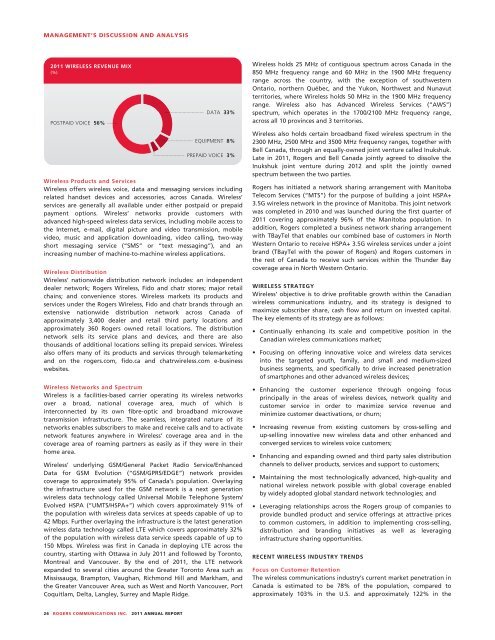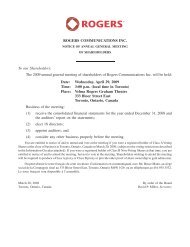CONNECTIONS COME ALIVE CONNECTIONS
CONNECTIONS COME ALIVE CONNECTIONS
CONNECTIONS COME ALIVE CONNECTIONS
Create successful ePaper yourself
Turn your PDF publications into a flip-book with our unique Google optimized e-Paper software.
MANAGEMENT’S DISCUSSION AND ANALYSIS<br />
2011 WIRELESS REVENUE MIX<br />
(%)<br />
POSTPAID VOICE 56%<br />
DATA 33%<br />
EQUIPMENT 8%<br />
PREPAID VOICE 3%<br />
Wireless Products and Services<br />
Wireless offers wireless voice, data and messaging services including<br />
related handset devices and accessories, across Canada. Wireless’<br />
services are generally all available under either postpaid or prepaid<br />
payment options. Wireless’ networks provide customers with<br />
advanced high-speed wireless data services, including mobile access to<br />
the Internet, e-mail, digital picture and video transmission, mobile<br />
video, music and application downloading, video calling, two-way<br />
short messaging service (“SMS” or “text messaging”), and an<br />
increasing number of machine-to-machine wireless applications.<br />
Wireless Distribution<br />
Wireless’ nationwide distribution network includes: an independent<br />
dealer network; Rogers Wireless, Fido and chatr stores; major retail<br />
chains; and convenience stores. Wireless markets its products and<br />
services under the Rogers Wireless, Fido and chatr brands through an<br />
extensive nationwide distribution network across Canada of<br />
approximately 3,400 dealer and retail third party locations and<br />
approximately 360 Rogers owned retail locations. The distribution<br />
network sells its service plans and devices, and there are also<br />
thousands of additional locations selling its prepaid services. Wireless<br />
also offers many of its products and services through telemarketing<br />
and on the rogers.com, fido.ca and chatrwireless.com e-business<br />
websites.<br />
Wireless Networks and Spectrum<br />
Wireless is a facilities-based carrier operating its wireless networks<br />
over a broad, national coverage area, much of which is<br />
interconnected by its own fibre-optic and broadband microwave<br />
transmission infrastructure. The seamless, integrated nature of its<br />
networks enables subscribers to make and receive calls and to activate<br />
network features anywhere in Wireless’ coverage area and in the<br />
coverage area of roaming partners as easily as if they were in their<br />
home area.<br />
Wireless’ underlying GSM/General Packet Radio Service/Enhanced<br />
Data for GSM Evolution (“GSM/GPRS/EDGE”) network provides<br />
coverage to approximately 95% of Canada’s population. Overlaying<br />
the infrastructure used for the GSM network is a next generation<br />
wireless data technology called Universal Mobile Telephone System/<br />
Evolved HSPA (“UMTS/HSPA+”) which covers approximately 91% of<br />
the population with wireless data services at speeds capable of up to<br />
42 Mbps. Further overlaying the infrastructure is the latest generation<br />
wireless data technology called LTE which covers approximately 32%<br />
of the population with wireless data service speeds capable of up to<br />
150 Mbps. Wireless was first in Canada in deploying LTE across the<br />
country, starting with Ottawa in July 2011 and followed by Toronto,<br />
Montreal and Vancouver. By the end of 2011, the LTE network<br />
expanded to several cities around the Greater Toronto Area such as<br />
Mississauga, Brampton, Vaughan, Richmond Hill and Markham, and<br />
the Greater Vancouver Area, such as West and North Vancouver, Port<br />
Coquitlam, Delta, Langley, Surrey and Maple Ridge.<br />
26 ROGERS COMMUNICATIONS INC. 2011 ANNUAL REPORT<br />
Wireless holds 25 MHz of contiguous spectrum across Canada in the<br />
850 MHz frequency range and 60 MHz in the 1900 MHz frequency<br />
range across the country, with the exception of southwestern<br />
Ontario, northern Québec, and the Yukon, Northwest and Nunavut<br />
territories, where Wireless holds 50 MHz in the 1900 MHz frequency<br />
range. Wireless also has Advanced Wireless Services (“AWS”)<br />
spectrum, which operates in the 1700/2100 MHz frequency range,<br />
across all 10 provinces and 3 territories.<br />
Wireless also holds certain broadband fixed wireless spectrum in the<br />
2300 MHz, 2500 MHz and 3500 MHz frequency ranges, together with<br />
Bell Canada, through an equally-owned joint venture called Inukshuk.<br />
Late in 2011, Rogers and Bell Canada jointly agreed to dissolve the<br />
Inukshuk joint venture during 2012 and split the jointly owned<br />
spectrum between the two parties.<br />
Rogers has initiated a network sharing arrangement with Manitoba<br />
Telecom Services (“MTS”) for the purpose of building a joint HSPA+<br />
3.5G wireless network in the province of Manitoba. This joint network<br />
was completed in 2010 and was launched during the first quarter of<br />
2011 covering approximately 96% of the Manitoba population. In<br />
addition, Rogers completed a business network sharing arrangement<br />
with TBayTel that enables our combined base of customers in North<br />
Western Ontario to receive HSPA+ 3.5G wireless services under a joint<br />
brand (TBayTel with the power of Rogers) and Rogers customers in<br />
the rest of Canada to receive such services within the Thunder Bay<br />
coverage area in North Western Ontario.<br />
WIRELESS STRATEGY<br />
Wireless’ objective is to drive profitable growth within the Canadian<br />
wireless communications industry, and its strategy is designed to<br />
maximize subscriber share, cash flow and return on invested capital.<br />
The key elements of its strategy are as follows:<br />
Continually enhancing its scale and competitive position in the<br />
Canadian wireless communications market;<br />
Focusing on offering innovative voice and wireless data services<br />
into the targeted youth, family, and small and medium-sized<br />
business segments, and specifically to drive increased penetration<br />
of smartphones and other advanced wireless devices;<br />
Enhancing the customer experience through ongoing focus<br />
principally in the areas of wireless devices, network quality and<br />
customer service in order to maximize service revenue and<br />
minimize customer deactivations, or churn;<br />
Increasing revenue from existing customers by cross-selling and<br />
up-selling innovative new wireless data and other enhanced and<br />
converged services to wireless voice customers;<br />
Enhancing and expanding owned and third party sales distribution<br />
channels to deliver products, services and support to customers;<br />
Maintaining the most technologically advanced, high-quality and<br />
national wireless network possible with global coverage enabled<br />
by widely adopted global standard network technologies; and<br />
Leveraging relationships across the Rogers group of companies to<br />
provide bundled product and service offerings at attractive prices<br />
to common customers, in addition to implementing cross-selling,<br />
distribution and branding initiatives as well as leveraging<br />
infrastructure sharing opportunities.<br />
RECENT WIRELESS INDUSTRY TRENDS<br />
Focus on Customer Retention<br />
The wireless communications industry’s current market penetration in<br />
Canada is estimated to be 78% of the population, compared to<br />
approximately 103% in the U.S. and approximately 122% in the



